The Complete Griddle Guide
Commercial Griddle Pricing Guide 2025
The Complete Flat Top Griddle Buyer's Guide
Based on analysis of 649 griddle sales with real market data
Average savings: 40-65% off retail prices🔥 Commercial Griddle Auction Prices by Size
Griddle pricing at auction follows clear patterns based on size, fuel type, and brand. Here's what 649 sales tell us about the current market:
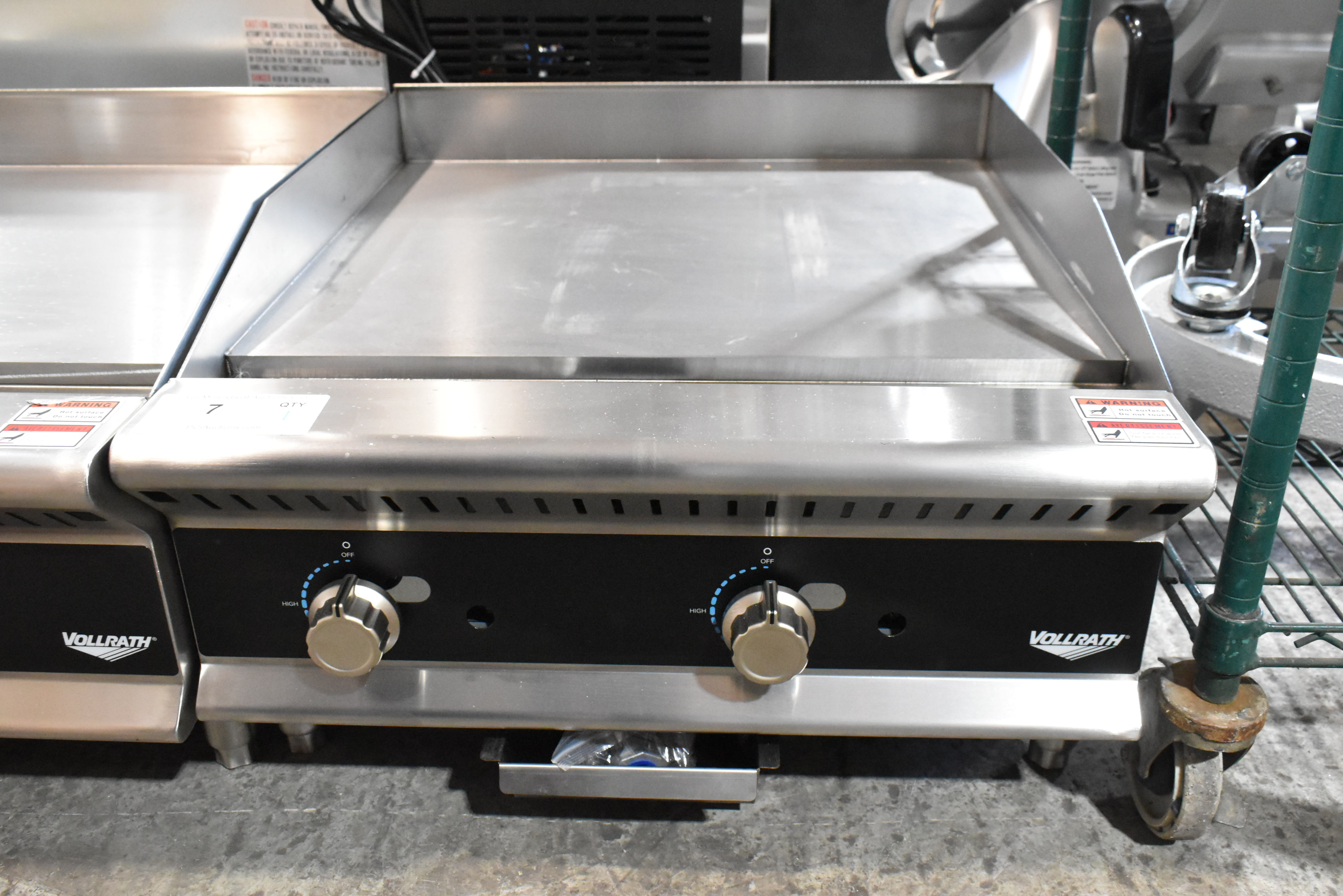
24" Griddles
$80-$565
Best for: Small cafes, food trucks, breakfast counters, limited space operations
Typical: 115V electric or gas, countertop mount
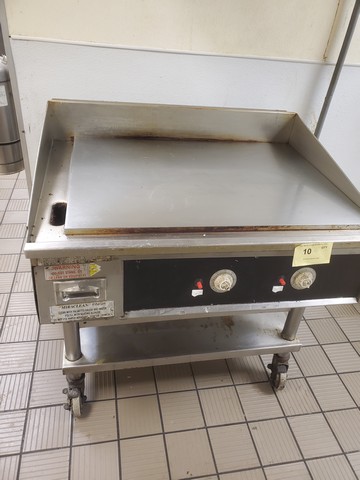
36" Griddles
$159-$716
Best for: The versatile workhorse - diners, burger joints, full-service restaurants
Typical: Natural gas, thermostatic controls available
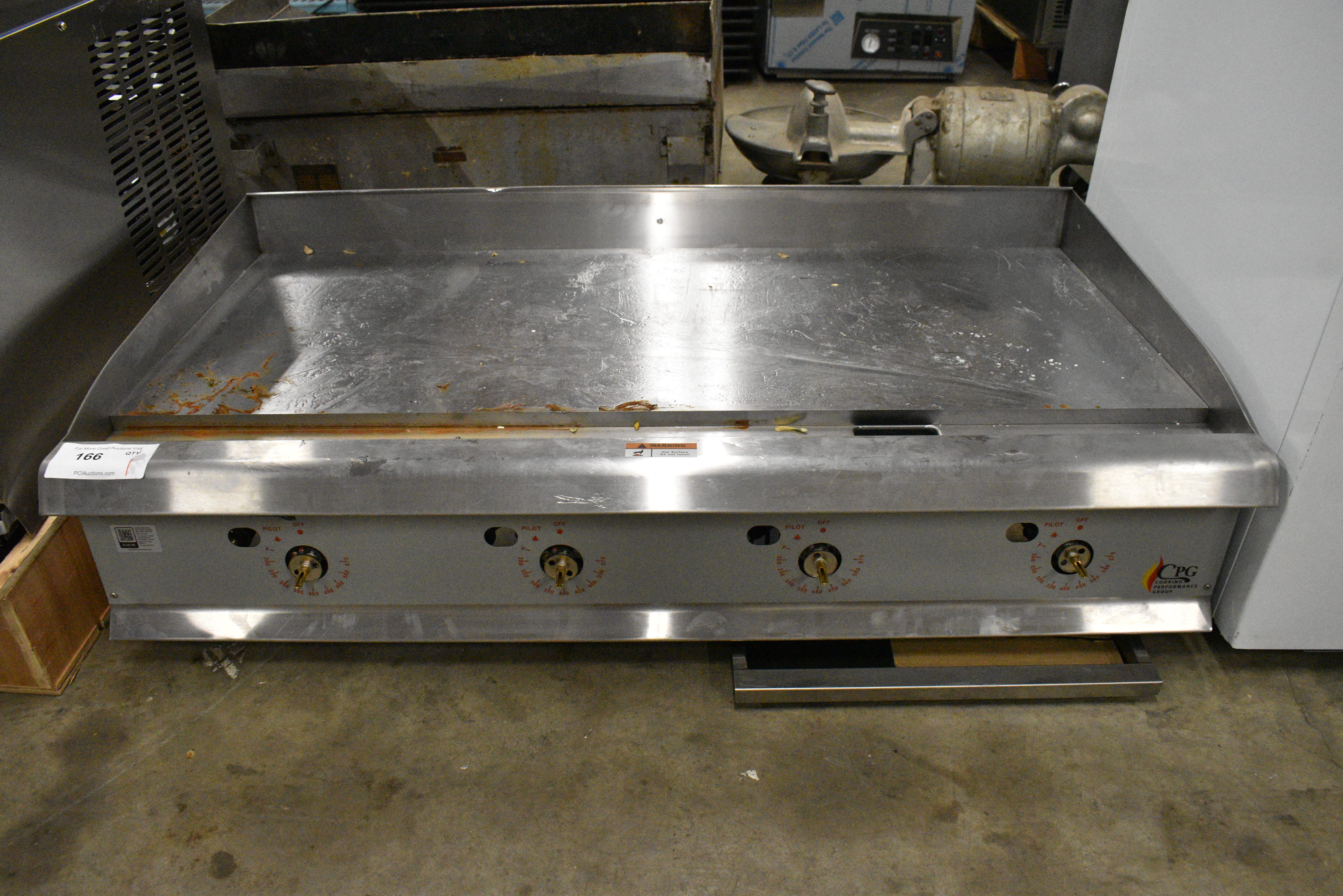
48" Griddles
$300-$3,300
Best for: High-volume operations, busy breakfast service, institutional kitchens
Typical: Natural gas, 100,000+ BTU
60" Griddles
$525-$6,650
Best for: Stadium concessions, hotel breakfast buffets, commissary operations
Typical: 150,000 BTU, thermostatic controls standard
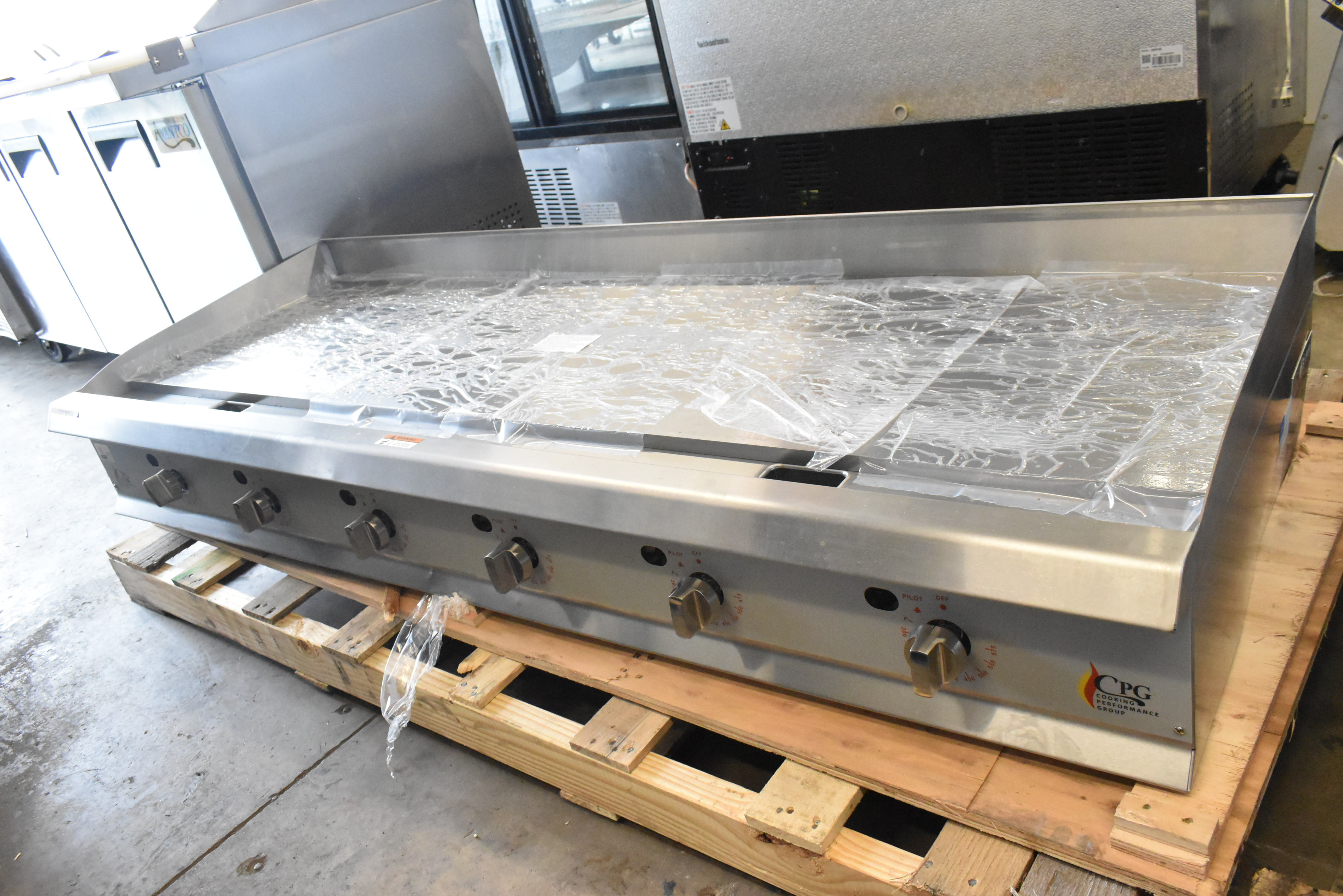
72"+ Griddles
$800-$2,400
Best for: Large-scale production, commercial bakeries, institutional feeding
Typical: Multiple zone controls, heavy-duty chassis
⚡ Gas vs Electric: The Reality
| Factor | Gas Griddles | Electric Griddles |
|---|---|---|
| Heat-Up Time | 10-15 minutes to full temp | 20-30 minutes to full temp |
| Recovery Time | Fast - minimal temp drop | Slower - noticeable lag |
| Heat Distribution | Even across surface | Can have hot/cold spots |
| Operating Cost | Lower (gas rates) | Higher (electric rates) |
| Installation | Requires gas line | 208V/240V wiring typical |
| Auction Average | $613 | $173 |
| Best Use Case | Any high-volume operation | When gas unavailable |
Power Requirements Breakdown
Electric Griddles:
- Small units (12-24"): 115V standard outlet, occasional use acceptable
- Commercial units (30"+): 208V or 240V required
- Single-phase more common but less efficient than three-phase
- Installation cost: $500-1,500 for dedicated circuit if not already present
Gas Griddles:
- Natural gas or propane (conversion kits available)
- BTU requirements vary by size - maximize what your gas supply allows
- Gas line installation: Nominal cost if kitchen already gas-equipped
- Conversion from LP to Natural Gas (or reverse): $200-400 plus labor
🏆 Brand Value Analysis
Not all griddles are created equal. Here's what our auction data reveals about brand performance and value:
| Brand | Avg. Price | Units Sold | Value Rating | Why It Matters |
|---|---|---|---|---|
| Garland | $1,061 | 60 | ⭐⭐⭐⭐⭐ | Premium quality steel, thick plates, commercial-grade durability |
| Wolf | $1,065 | 12 | ⭐⭐⭐⭐⭐ | Top-tier construction, exceptional heat distribution |
| SouthBend | $831 | 19 | ⭐⭐⭐⭐ | Solid mid-premium range, reliable workhorses |
| Vulcan | $761 | 42 | ⭐⭐⭐⭐ | Well-made, widely serviceable, good parts availability |
| CPG | $763 | 85 | ⭐⭐⭐⭐ | Best value for the money - not quite premium but worth every penny |
| Star | $218 | 34 | ⭐⭐⭐ | Budget-friendly, adequate for light-duty |
| Avantco | $147 | 129 | ⭐⭐ | Import quality - fine for occasional use, not high-volume |
Special Mention: Keating Miraclean
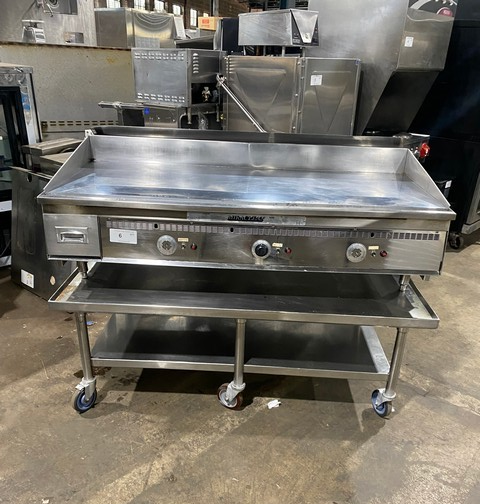
Keating Miraclean with polished chrome cooking surface
Why Miraclean Units Command Premium Prices:
- Chrome cooking surface: Non-stick, non-porous surface for delicate items like eggs and fish
- No radiant heat: Significantly cooler kitchen environment, energy savings
- Superior heat retention: Faster recovery times between batches
- Easy cleaning: Wipes clean in minutes vs extensive scraping/seasoning
- Less shrinkage: Food cooks at lower surface temperature with better yield
Trade-offs: Higher initial cost, requires special cleaning materials and non-metallic utensils, chrome surface less durable than steel with heavy use.
🔧 Griddle Plate Thickness: Why It's Critical
The cooking surface is the heart of the griddle. Plate thickness determines performance more than any other single factor.
| Thickness | Heat-Up Time | Heat Retention | Recovery Speed | Best For |
|---|---|---|---|---|
| 3/8" - 1/2" | Fast (10-12 min) | Moderate | Slower | Low-volume, occasional use, budget operations |
| 3/4" | Medium (15-18 min) | Good | Fast | General-purpose commercial use - the standard |
| 1" | Slower (20-25 min) | Excellent | Fastest | High-volume operations, minimal temp drop |
Chrome vs Standard Steel Surface
Chrome Griddle Surface
Advantages:
- Non-stick, non-porous surface
- Radiant heat stays in the griddle, not the kitchen
- Fast cleaning - minutes vs hours
- Superior for delicate foods
- Aesthetically appealing for open kitchens
Disadvantages:
- Higher initial cost
- Requires special cleaning materials
- Must use non-metallic utensils
- Less durable with abuse
Standard Steel Surface
Advantages:
- Lower upfront cost
- Extremely durable
- Can use metal utensils
- Easy to resurface if damaged
- More forgiving with maintenance
Disadvantages:
- Requires seasoning and maintenance
- More labor-intensive cleaning
- Higher radiant heat (hotter kitchen)
- Can rust if neglected
Auction Reality: Chrome griddles are uncommon in our auctions. For most kitchens, the simplicity and durability of standard steel makes it the preferred choice. Chrome makes sense for high-volume breakfast operations cooking delicate items, or operations prioritizing easy cleaning over durability.
🔍 Pre-Purchase Inspection Checklist
Use this checklist when previewing griddles at auction. These inspection points can save you thousands in repair costs:
Critical Inspection Points
What to Look For (Good Signs)
- Flat cooking surface: Use a straight edge - plate should sit perfectly flat on chassis
- Clean, well-seasoned surface: Dark, uniform patina indicates proper care
- Smooth control operation: Knobs turn freely through full range
- Grease trap slides easily: Should pull out and reinsert smoothly
- Clear data plate: Verify fuel type, voltage, BTU rating matches your needs
- No visible gas line damage: Connections, valves, fittings intact
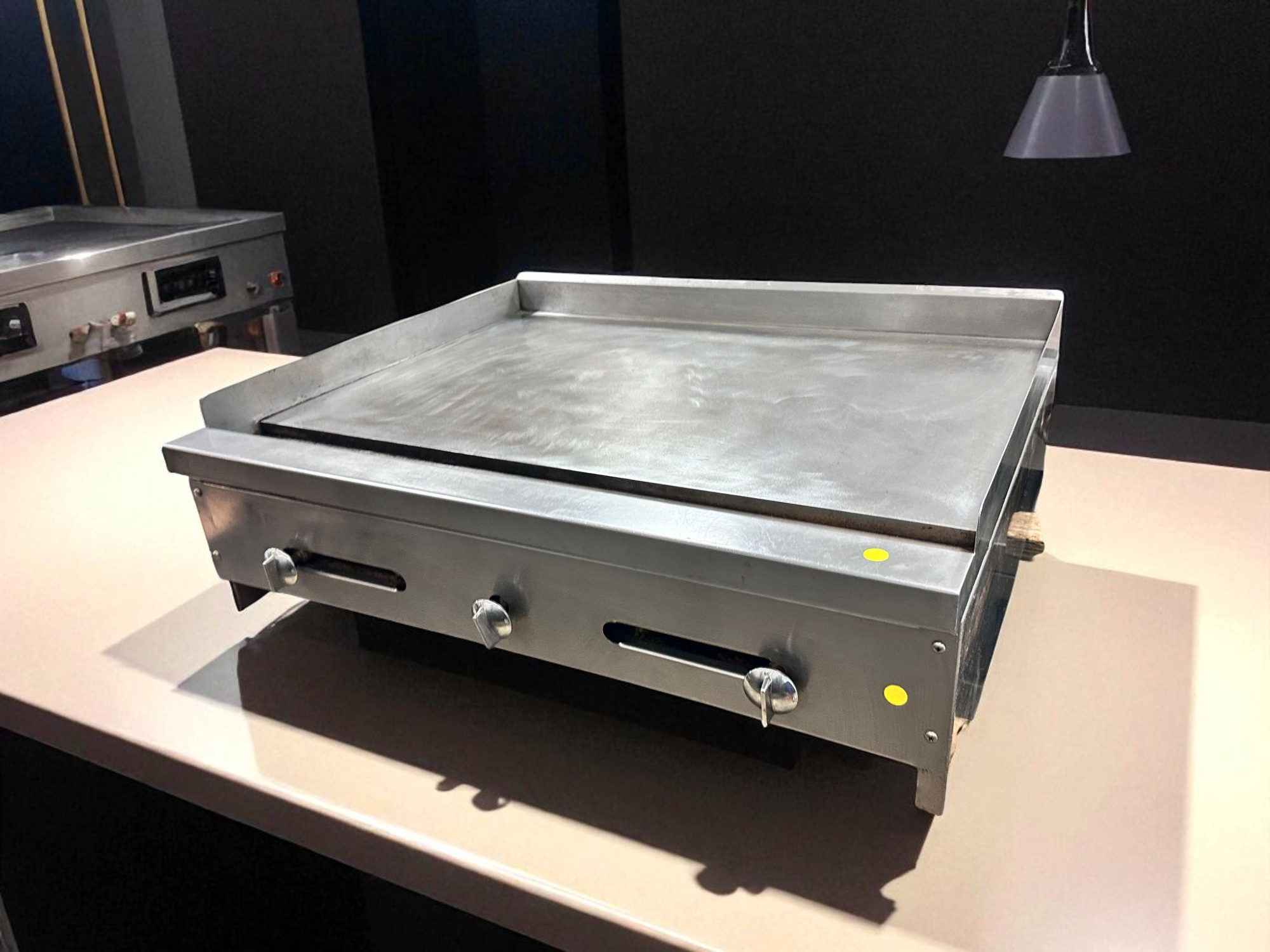
Example of a properly seasoned griddle surface - dark, uniform patina
Red Flags - Walk Away If You See:
- Warped cooking surface: Visible gaps when straight edge placed across plate
- Deep pitting: Erosion beyond surface level indicates water damage or severe neglect
- Stuck/damaged grease trap: Bent or buckled traps damage mounting rails
- Missing control knobs: May indicate deeper mechanical issues
- Cracked griddle plate: Structural damage, not repairable
- Heavy corrosion on gas components: Safety hazard, expensive repairs
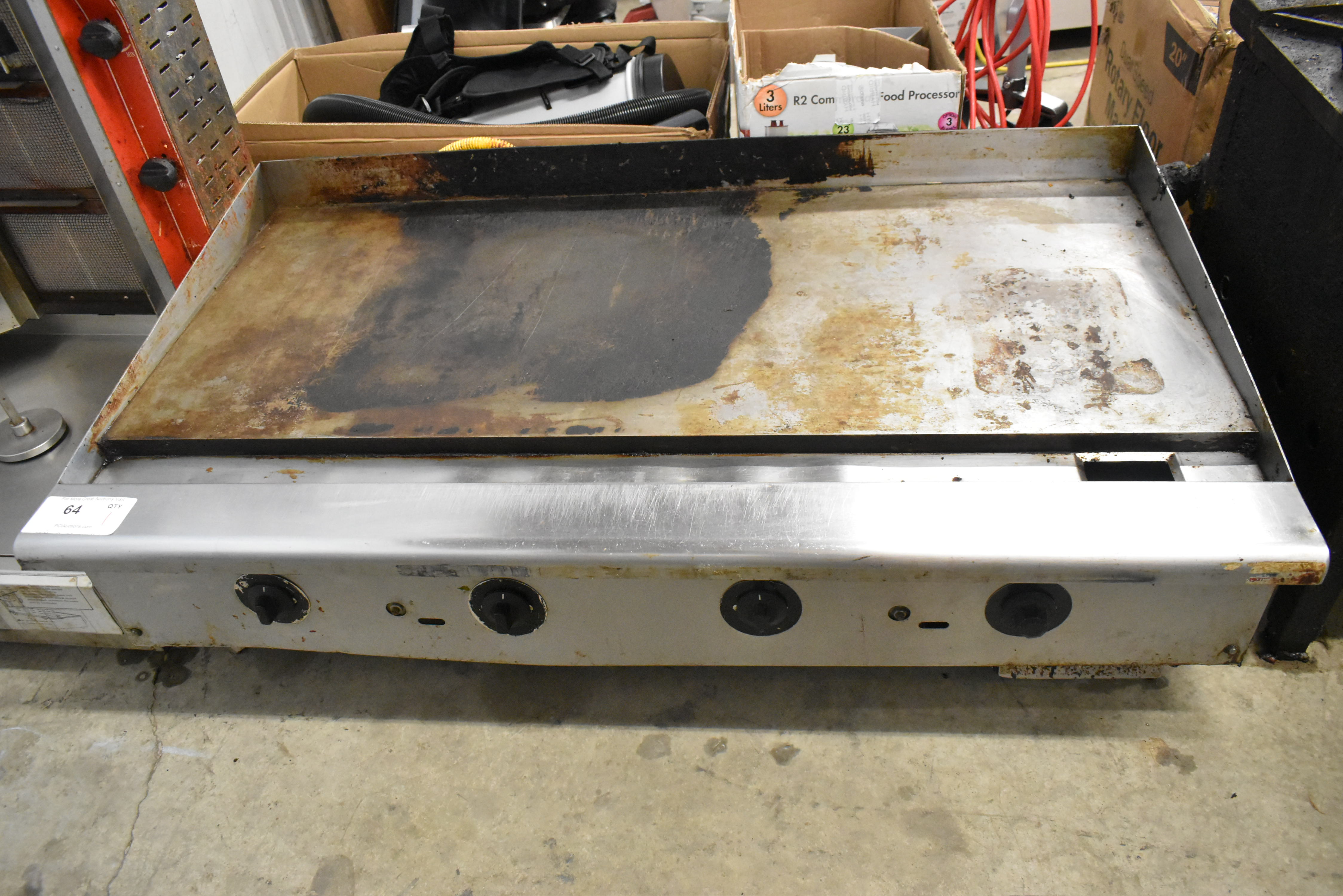
Warped griddle plate - this unit is only good for parts
Surface Condition Assessment
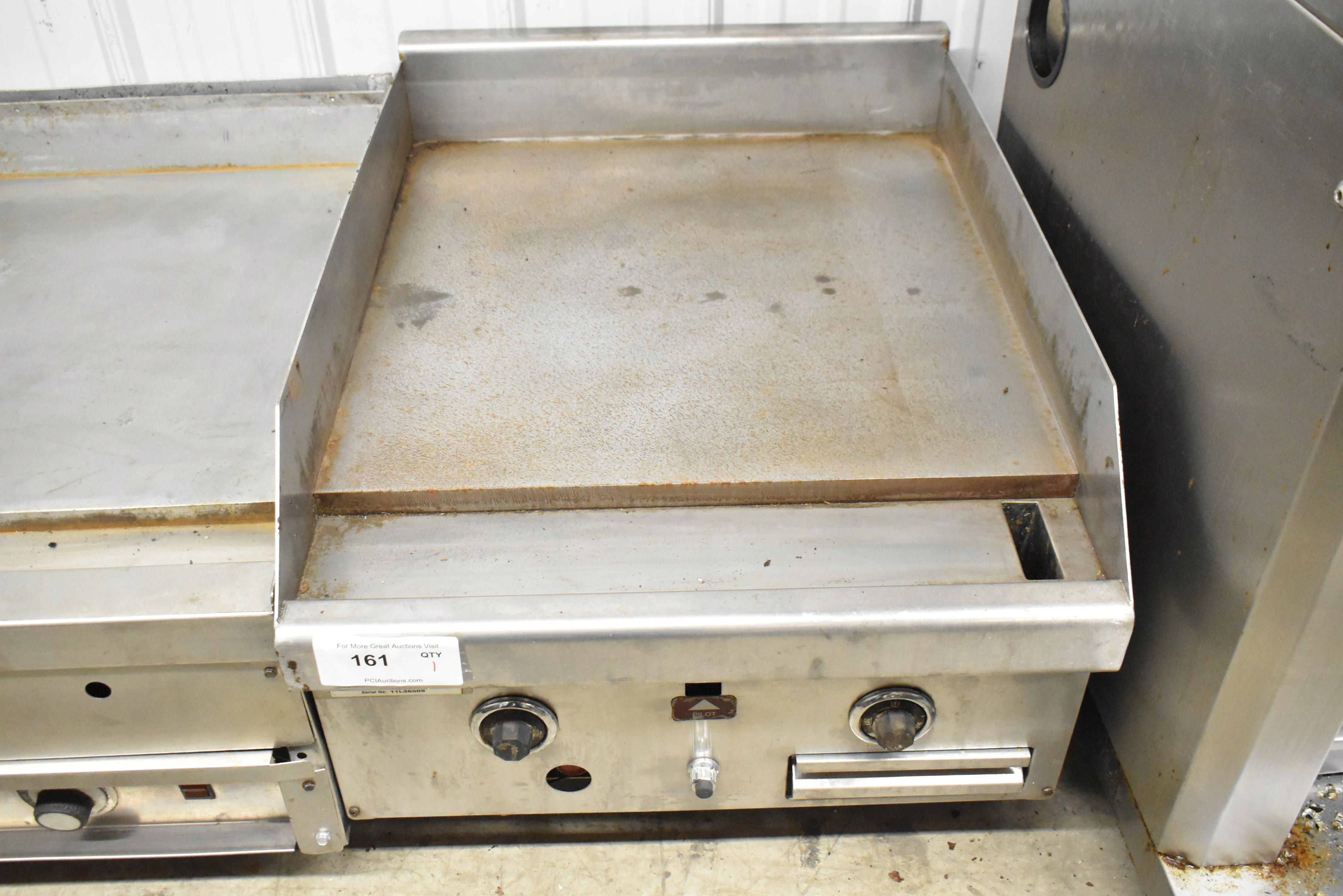
Surface rust and early pitting - repairable but requires work
Control Systems

Thermostatic controls - precise temperature regulation
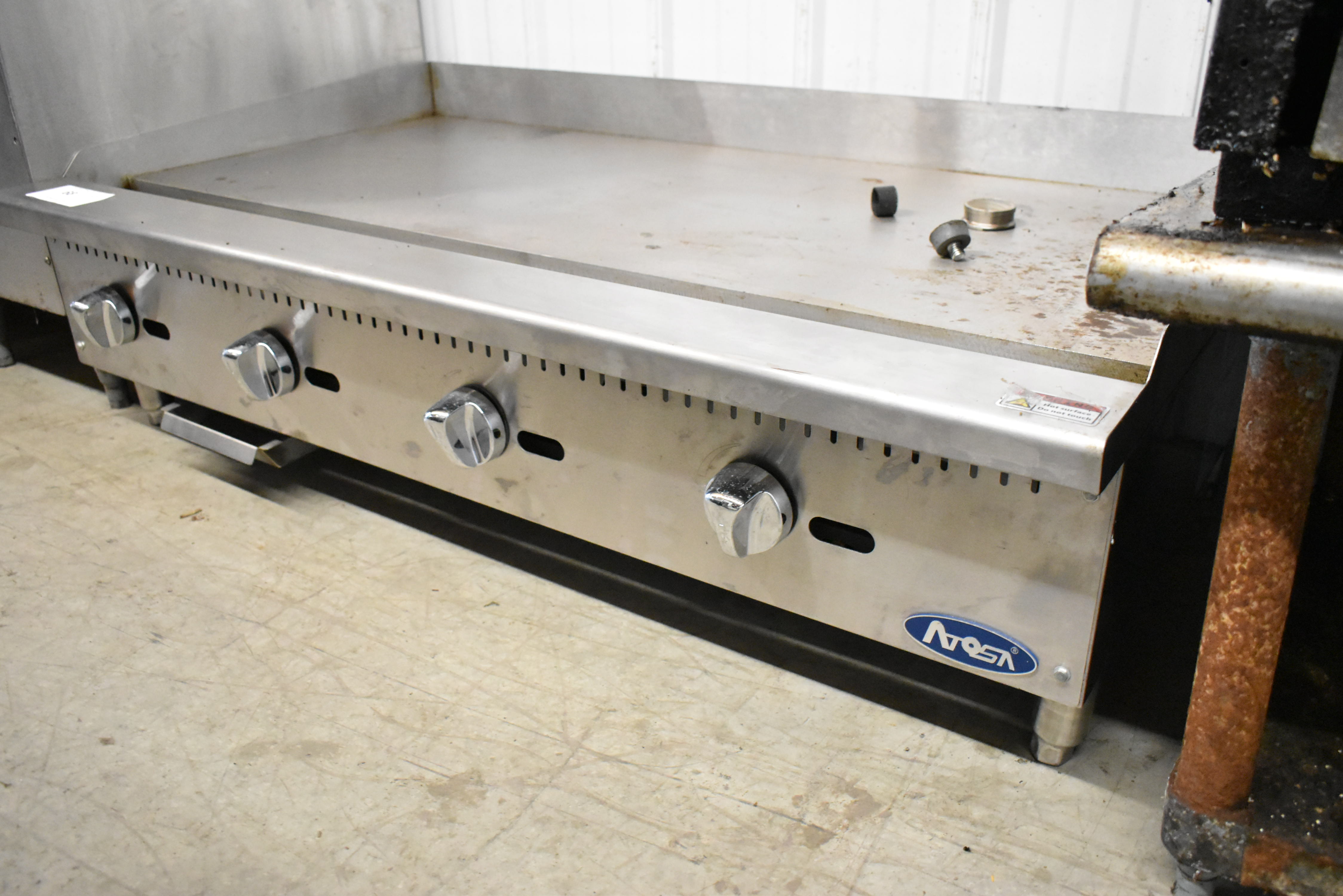
Manual controls - simple low/medium/high adjustment
Thermostatic vs Manual Controls
Thermostatic Controls: Precise, automated temperature regulation ideal for consistent cooking and holding temperatures. Premium cost, more components that can fail. Replacement cost: $200-400 per control valve.
Manual Controls: Basic heat adjustment adequate for experienced cooks. Less expensive, fewer failure points. Requires more active temperature management during service.
Grease Management System

Grease trap should slide in and out smoothly
The grease trap is a catch tray that's emptied periodically - not plumbed into the drain system. Test that it slides out fully and reinstalls without resistance. Bent or stuck traps indicate abuse and can damage the mounting rails, requiring fabrication to repair.
🔥 BTU Ratings: What You Actually Need
Higher BTU means faster heating and better temperature recovery. But BTU requirements must balance against your kitchen's gas supply capacity.
Typical BTU Ratings by Size
| Griddle Size | Typical BTU Range | What This Means |
|---|---|---|
| 24" | 50,000 - 72,000 | Adequate for small operations, slower recovery |
| 36" | 75,000 - 108,000 | Good balance of power and efficiency |
| 48" | 100,000 - 144,000 | High-volume capability, fast recovery |
| 60" | 120,000 - 180,000 | Commercial-grade power for continuous operation |
| 72" | 150,000 - 216,000 | Maximum capacity for large-scale production |
Why BTU Matters: During rush service, you're constantly placing cold food on the hot surface. Higher BTU means faster temperature recovery, less wait time between batches, and more consistent cooking results. This directly impacts your throughput during peak hours.
💰 Hidden Costs & Maintenance Reality
Seasoning Your Griddle
Break-In Period: New or resurfaced griddles require proper seasoning before use.
- Heat griddle to 350°F
- Apply thin layer of high-temp neutral oil (canola, grapeseed)
- Sprinkle liberally with salt
- Spread oil and salt mixture across entire surface
- Let cook for 20-30 minutes until oil smokes and turns dark
- Repeat process 3-4 times before first use
Daily Maintenance: Clean thoroughly after each service, but always reapply food-grade oil. Keep a bottle of high-temp oil at the griddle station for use during cooking, especially with low-fat proteins like chicken breast and vegetables.
Surface Rust Removal Process
For brand-new scratch-and-dent units with surface rust (a value opportunity):
- Start with 80-grit sandpaper on orbital sander
- Work in overlapping circular motions across entire surface
- Progress to 120-grit, then 220-grit for smooth finish
- Use edge attachments to clean corners thoroughly
- Wipe surface completely clean
- Apply oil and begin standard seasoning process
Gas Conversion (Natural Gas ↔ Propane)
Conversions are fairly common but not DIY-friendly:
- Requires removing griddle plate to access burners (can weigh 500+ pounds for large units)
- Replace orifices with correct size for new fuel type
- Replace gas regulator
- Test all connections for leaks
- Conversion kits: $100-200 from manufacturer or parts suppliers
- Professional installation recommended: $200-400 labor
Resurfacing a Damaged Plate
Due to plate thickness (3/4" to 1"), even deeply pitted surfaces can be remediated:
- Professional resurfacing: $300-800 depending on size
- Must be done away from kitchen (metal shards)
- Requires complete re-seasoning after
- Only viable if plate is not warped or cracked
Actual Operating Costs
| Expense | Frequency | Cost |
|---|---|---|
| Daily cleaning supplies | Daily | $20-40/month |
| Seasoning oil | Daily | $30-50/month |
| Thermostatic control replacement | As needed | $200-400 each |
| Gas valve replacement | Uncommon | $150-300 |
| Plate resurfacing | Every 5-10 years | $300-800 |
| Professional deep clean | Quarterly | $200-400 |
💡 Pro Tips: Insider Knowledge
Countertop vs Floor Model Decision
Countertop models win in most scenarios: Mount them on chef's bases (refrigerated drawer systems) to maximize efficiency. Food goes from refrigeration directly onto the cooking surface - streamlined workflow and space efficiency.
Floor models with dry storage: Only advantageous if you have existing holding infrastructure elsewhere or abundant space. For most kitchens, the countertop + chef's base combination is superior.
Chef's Base Integration
A chef's base is a refrigerated drawer system that allows equipment to be installed on top. This setup provides:
- Ingredients at arm's reach below cooking surface
- No wasted vertical space
- Improved kitchen flow during service
- Better use of prime real estate
Chef's bases are common enough that most commercial kitchen designers assume this configuration.
Hot Side / Warm Side Setup
Create temperature zones on your griddle for maximum versatility:
- Set one side to full temperature for primary cooking
- Set opposite side to lower temp for holding/warming
- Use burner controls to maintain each zone
- Allows continuous cooking without overcooking finished items
Grid Cooking Technique
For volume cooking (burgers, pancakes, etc.), treat the griddle surface like a grid:
- Mentally divide surface into sections (3x4 grid, etc.)
- Place items in specific grid positions at timed intervals
- Track cooking progress by grid location
- Assembly-line style ensures consistent results
- Maintains uniform heat distribution across surface
Casters vs Legs
Advantages of casters: Ability to move unit for thorough cleaning around entire perimeter. Heavy units on fixed legs become difficult to clean around.
Disadvantages of casters: Become grease-covered and require regular attention to prevent debris buildup. Can also reduce stability if not properly locked during service.
Splash Guards & Backsplash
At cooking temperature, grease splatters significantly. Griddles need guards around the cooking surface:
- Many units include basic guards at sides and rear
- Additional guards can be added based on cooking techniques and space
- Open griddles without guards create cleanup nightmares
- Consider your menu - high-fat items require more protection
The Scratch-and-Dent Opportunity
Smart Buyer Move: Brand new scratch-and-dent griddles with surface rust often sell for 30-50% less than clean equivalents. This is cosmetic damage only - the rust removes easily with sanding and proper seasoning restores the surface completely. You're getting new equipment at used prices for a few hours of prep work.
📊 Use Case Guide: Matching Griddle to Operation
| Operation Type | Recommended Size | Fuel Type | Key Features | Target Auction Price |
|---|---|---|---|---|
| Food Truck | 24-36" | Propane (gas) | Compact, high BTU, countertop | $400-700 |
| Small Cafe/Bistro | 24-30" | Gas or 115V electric | Space-efficient, adequate for 50-75 covers | $200-500 |
| Full-Service Restaurant | 36-48" | Natural gas | Thermostatic controls, 3/4" plate minimum | $600-1,200 |
| Breakfast-Heavy Diner | 48-60" | Natural gas | High BTU, thick plate (1"), dual zones | $800-1,800 |
| Burger Joint | 36-48" | Natural gas | High BTU for fast recovery, standard steel | $500-1,000 |
| Hotel Breakfast Buffet | 60-72" | Natural gas | Multiple zones, thermostatic, holding capability | $1,200-2,500 |
| Stadium Concession | 60" | Natural gas | Maximum BTU, fast recovery, heavy-duty | $1,000-2,000 |
| Commissary/Institutional | 72"+ | Natural gas | Commercial-grade, multiple operators, thick plate | $1,500-3,000 |
Production Output Reality
Output is 100% dependent on food type, plate thickness (thermal mass), and energy input. There's no universal "200 burgers per hour" formula because a 1/4-lb smash burger cooks differently than a 1/2-lb thick patty. The key factors:
- Plate thickness: Thicker plates maintain temperature better under load
- BTU rating: Higher BTU means faster temperature recovery
- Food characteristics: Frozen vs fresh, thickness, fat content all affect cook time
- Operator skill: Experienced cooks maximize griddle real estate efficiently
❓ Frequently Asked Questions
Should I buy a gas or electric griddle?
Choose gas if available. Gas griddles heat faster, recover temperature quicker after food is placed, and distribute heat more evenly. Electric griddles average $173 at auction while gas units average $613, but the performance gap justifies the premium. Electric is only recommended when gas lines aren't available or can't be installed.
What size griddle do I need for my restaurant?
Size depends on volume and space. A 24-inch griddle works for small cafes or food trucks. A 36-inch griddle is the versatile workhorse for most restaurants. 48-60 inch griddles handle high-volume operations like diners and hotel breakfast service. Remember: in compact kitchens, every inch matters. A countertop model on a chef's base maximizes efficiency.
How important is griddle plate thickness?
Critical for performance. Thicker plates (3/4" to 1") offer better heat retention, faster temperature recovery after food placement, more even heating, and resist warping over time. Thinner plates (3/8" to 1/2") heat faster and cost less but require more recovery time between batches. For high-volume operations, invest in thicker plates.
What BTU rating should I look for?
Get the highest BTU your gas lines can accommodate. Higher BTU means faster heating and better temperature recovery. Typical ratings: 60-inch griddles run around 150,000 BTU. The BTU-to-cooking-surface ratio determines efficiency more than any other factor. However, BTU needs must be balanced against your kitchen's total gas supply capacity.
Can I convert a griddle from natural gas to propane?
Yes, conversion is fairly common. The process requires replacing orifices and the regulator. The main challenge is removing the griddle plate to access the burners - large plates can weigh 500+ pounds. Many manufacturers provide conversion kits, and some units ship with both orifice sets included. Unless you have equipment to safely lift heavy steel, hire a qualified technician.
Should I avoid griddles with surface rust?
No - surface rust on otherwise good griddles is an opportunity. Brand new scratch-and-dent units with surface rust sell for significantly less than equivalent clean units. The rust can be removed with orbital sanding, then the surface seasoned normally. This doesn't compromise the griddle's function and can save hundreds of dollars if you're willing to do the prep work.
Are thermostatic controls worth the extra cost?
Thermostatic controls offer precise, automated temperature regulation ideal for consistent cooking and holding temperatures. Manual controls provide basic heat adjustment (low, medium, high) and work fine for experienced cooks. Thermostatic models cost more upfront and have more components that can fail (replacement runs $200-400 per control valve). For operations prioritizing consistency, thermostatic is worth it.
What's the difference between countertop and floor models?
Countertop models mount on chef's bases (refrigerated drawer systems), maximizing efficiency by placing refrigerated ingredients directly below the cooking surface. Floor models with dry storage underneath work if you have existing holding infrastructure or abundant space, but for most operations, countertop models on chef's bases are more space-efficient and improve workflow.
Why do Garland and Wolf griddles command premium prices?
Top-tier construction using high-quality steel, thick cooking plates for superior heat retention and distribution, commercial-grade durability that lasts decades, and consistent even cooking across the entire surface. Our auction data shows these brands averaging $1,000-1,100 compared to imports at $150-200. The performance difference justifies the investment for serious operations.
What about grooved griddles?
Grooved griddle tops are a poor replacement for a char griller. They add grill marks to food and channel grease away, but don't provide the flavor development of true char-grilling. For most operations, a standard flat top offers more versatility.
🔥 Current Griddle Inventory at PCI Auctions
We typically have 20-35 commercial griddles available each week
Recent additions include Garland, Vulcan, Wolf, and complete kitchen packages with griddles included
View Current Griddles Call: 717-945-3986Set up email alerts for specific brands or sizes to get first access to new listings
